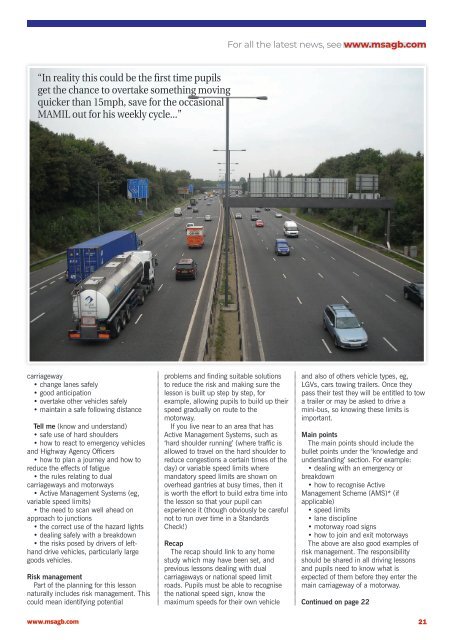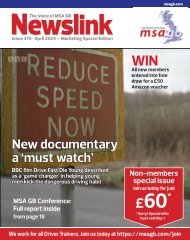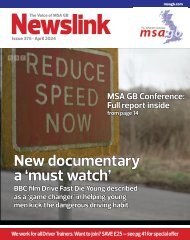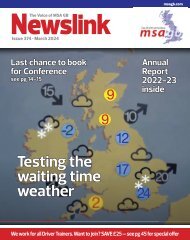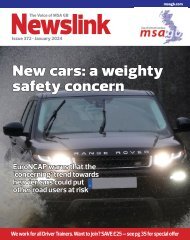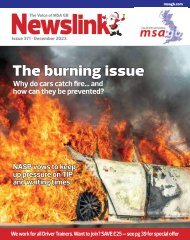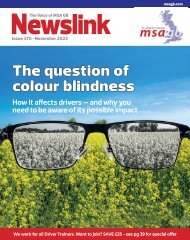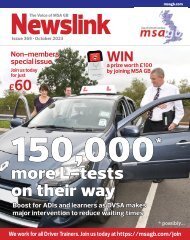Newslink February 2021
Motor Schools Association of Great Britain membership magazine; driver training and testing; road safety.
Motor Schools Association of Great Britain membership magazine; driver training and testing; road safety.
Create successful ePaper yourself
Turn your PDF publications into a flip-book with our unique Google optimized e-Paper software.
For all the latest news, see www.msagb.com<br />
“In reality this could be the first time pupils<br />
get the chance to overtake something moving<br />
quicker than 15mph, save for the occasional<br />
MAMIL out for his weekly cycle...”<br />
carriageway<br />
• change lanes safely<br />
• good anticipation<br />
• overtake other vehicles safely<br />
• maintain a safe following distance<br />
Tell me (know and understand)<br />
• safe use of hard shoulders<br />
• how to react to emergency vehicles<br />
and Highway Agency Officers<br />
• how to plan a journey and how to<br />
reduce the effects of fatigue<br />
• the rules relating to dual<br />
carriageways and motorways<br />
• Active Management Systems (eg,<br />
variable speed limits)<br />
• the need to scan well ahead on<br />
approach to junctions<br />
• the correct use of the hazard lights<br />
• dealing safely with a breakdown<br />
• the risks posed by drivers of lefthand<br />
drive vehicles, particularly large<br />
goods vehicles.<br />
Risk management<br />
Part of the planning for this lesson<br />
naturally includes risk management. This<br />
could mean identifying potential<br />
problems and finding suitable solutions<br />
to reduce the risk and making sure the<br />
lesson is built up step by step, for<br />
example, allowing pupils to build up their<br />
speed gradually on route to the<br />
motorway.<br />
If you live near to an area that has<br />
Active Management Systems, such as<br />
‘hard shoulder running’ (where traffic is<br />
allowed to travel on the hard shoulder to<br />
reduce congestions a certain times of the<br />
day) or variable speed limits where<br />
mandatory speed limits are shown on<br />
overhead gantries at busy times, then it<br />
is worth the effort to build extra time into<br />
the lesson so that your pupil can<br />
experience it (though obviously be careful<br />
not to run over time in a Standards<br />
Check!)<br />
Recap<br />
The recap should link to any home<br />
study which may have been set, and<br />
previous lessons dealing with dual<br />
carriageways or national speed limit<br />
roads. Pupils must be able to recognise<br />
the national speed sign, know the<br />
maximum speeds for their own vehicle<br />
and also of others vehicle types, eg,<br />
LGVs, cars towing trailers. Once they<br />
pass their test they will be entitled to tow<br />
a trailer or may be asked to drive a<br />
mini-bus, so knowing these limits is<br />
important.<br />
Main points<br />
The main points should include the<br />
bullet points under the ‘knowledge and<br />
understanding’ section. For example:<br />
• dealing with an emergency or<br />
breakdown<br />
• how to recognise Active<br />
Management Scheme (AMS)* (if<br />
applicable)<br />
• speed limits<br />
• lane discipline<br />
• motorway road signs<br />
• how to join and exit motorways<br />
The above are also good examples of<br />
risk management. The responsibility<br />
should be shared in all driving lessons<br />
and pupils need to know what is<br />
expected of them before they enter the<br />
main carriageway of a motorway.<br />
Continued on page 22<br />
www.msagb.com<br />
21


